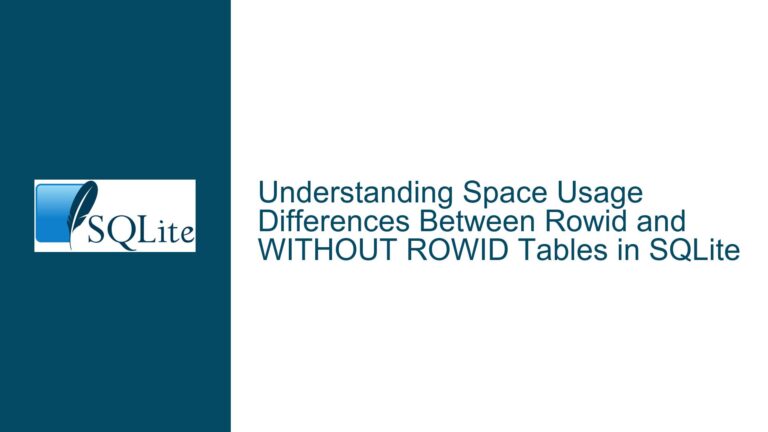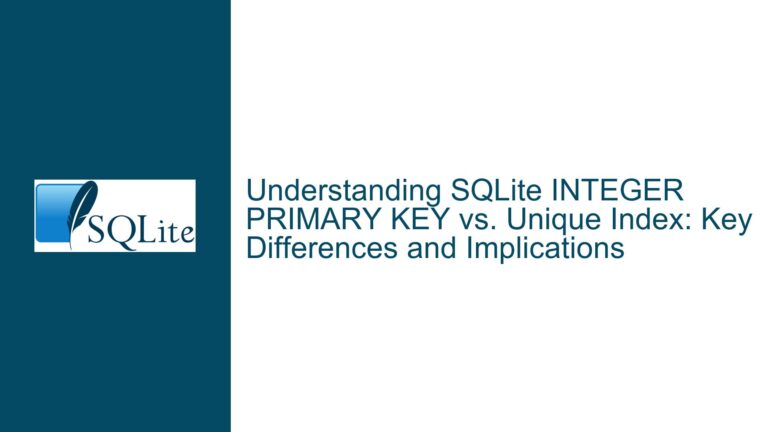Using Temp Tables to Override Main Tables in SQLite: Risks and Best Practices
Understanding the Behavior of Temp Tables Overriding Main Tables in SQLite
The core issue revolves around the use of temporary tables in SQLite to override or hide data in main tables of the same name. This technique is employed to dynamically switch between data sources without modifying the underlying SELECT statements. While this approach works in practice, it raises questions about its reliability, support in SQLite, and potential risks. This post will explore the behavior of temporary tables in SQLite, the implications of using them to override main tables, and alternative strategies to achieve the same goal.
The Mechanics of Temp Tables and Schema Precedence in SQLite
SQLite follows a specific order when resolving table names: temporary tables take precedence over main tables, which in turn take precedence over tables in attached databases. This behavior is documented in the SQLite documentation under the section on Table and Index Names. When a query references a table name without a schema qualifier, SQLite searches for the table in the following order: temp, main, and then any attached databases in the order they were attached.
In the scenario described, temporary tables are created in the temp schema with the same names as the tables in the main schema. When a SELECT statement references a table name, SQLite first checks the temp schema. If a table with the matching name exists in temp, SQLite uses that table. If no such table exists in temp, SQLite falls back to the main schema and then to any attached databases. This behavior allows the application to dynamically switch between data sources by creating or dropping temporary tables.
However, this approach relies on an implicit behavior that is not explicitly documented as a supported feature. While it works in practice, there is no guarantee that future versions of SQLite will maintain this behavior. Additionally, using temporary tables in this way can introduce complexity and potential risks, particularly in multi-threaded or concurrent environments where multiple connections might interact with the same database.
Security and Consistency Concerns with Cross-Schema References
One of the key considerations when using temporary tables to override main tables is the security and consistency implications. SQLite restricts certain operations to the temp schema for security reasons. For example, some functions and virtual tables require "direct access," meaning they can only be referenced in the temp schema. This restriction ensures that these operations are only performed under the explicit control of the application, reducing the risk of unintended behavior or security vulnerabilities.
In contrast, other relational database management systems (RDBMS) allow cross-schema references by default, enabling queries to access tables across multiple schemas within the same connection. SQLite, however, does not support this level of cross-schema interaction. Each connection in SQLite is tied to a single schema, and the schema must be internally consistent. This design choice simplifies the database engine but limits the flexibility of cross-schema operations.
When using temporary tables to override main tables, it is essential to ensure that the application maintains consistency across schemas. For example, if a temporary table is created with the same name as a main table, any subsequent queries that reference the table name will use the temporary table. If the temporary table is dropped, queries will revert to using the main table. This behavior can lead to inconsistencies if the application does not carefully manage the lifecycle of temporary tables.
Alternative Strategies for Dynamic Data Source Switching
While using temporary tables to override main tables is a viable approach, there are alternative strategies that may offer better reliability and maintainability. One such strategy is to use views or common table expressions (CTEs) to dynamically switch between data sources. Views can be created to reference tables in different schemas, and the application can switch between views as needed. This approach avoids the need to create and drop temporary tables, reducing the risk of inconsistencies and simplifying the application logic.
Another alternative is to use a combination of ATTACH DATABASE and schema-qualified table names in queries. By attaching multiple databases and explicitly specifying the schema in queries, the application can dynamically switch between data sources without relying on temporary tables. For example, instead of creating a temporary table, the application can attach the secondary database and use schema-qualified table names in queries. This approach provides greater control over data source switching and avoids the potential pitfalls of temporary tables.
Best Practices for Using Temp Tables in SQLite
If the decision is made to use temporary tables to override main tables, it is essential to follow best practices to minimize risks and ensure consistent behavior. First, ensure that the application explicitly manages the lifecycle of temporary tables, creating and dropping them as needed. Avoid relying on implicit behaviors or undocumented features, as these may change in future versions of SQLite.
Second, consider the impact of temporary tables on concurrency and multi-threaded environments. Temporary tables are specific to the connection that creates them, meaning that other connections will not see the temporary tables. If multiple connections interact with the same database, ensure that the use of temporary tables does not introduce race conditions or inconsistencies.
Finally, document the use of temporary tables and the rationale behind the approach. Clear documentation will help other developers understand the design decisions and ensure that the application logic remains maintainable over time. If possible, include comments in the code that explain the purpose of temporary tables and the expected behavior.
Conclusion
Using temporary tables to override main tables in SQLite is a powerful technique that allows applications to dynamically switch between data sources without modifying the underlying queries. However, this approach relies on implicit behaviors that are not explicitly documented as supported features. While it works in practice, there are potential risks and limitations, particularly in multi-threaded or concurrent environments.
Alternative strategies, such as using views or schema-qualified table names, may offer better reliability and maintainability. If temporary tables are used, it is essential to follow best practices to minimize risks and ensure consistent behavior. By carefully managing the lifecycle of temporary tables and documenting the design decisions, applications can leverage the flexibility of temporary tables while avoiding potential pitfalls.
In summary, while the use of temporary tables to override main tables is a viable approach in SQLite, it is essential to understand the underlying mechanics, consider the security and consistency implications, and explore alternative strategies. By following best practices and maintaining clear documentation, developers can ensure that their applications remain robust and maintainable over time.






